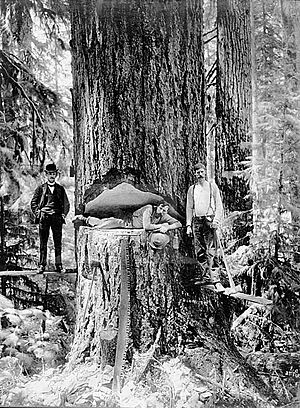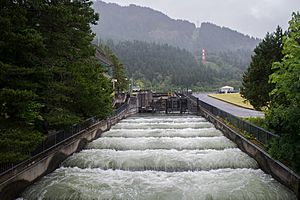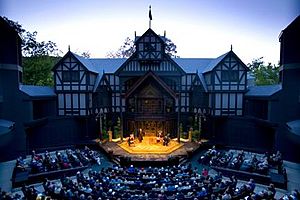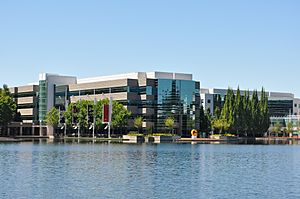Economy of Oregon facts for kids

The Oregon State version of the U.S. Quarter features Crater Lake.
|
|
| Statistics | |
|---|---|
|
GDP per capita
|
$45,049 (2016) |
|
Population below poverty line
|
15.5% (2008-2012) |
| 0.4586 | |
|
Labor force
|
2,159,278 (7/2023) |
| Unemployment | 3.4% (5/2017) |
| Public finances | |
| Revenues | $7,475.135 million |
| Expenses | $5,889 million |
The economy of Oregon is made up of many different parts. For a long time, Oregon's economy relied on its natural resources like timber and fishing. But in the 1990s and 2000s, Oregon started to change. It began focusing more on manufacturing, services, and high technology.
In the 1980s, industries like timber, fishing, and farming faced tough times. To help, the state government worked to bring in new types of businesses. This led to a big growth in Oregon's high-tech industry. Most of these new tech jobs were in the three counties around Portland, Oregon. However, rural areas of the state did not see as much growth.
When the "tech bubble" burst in the early 2000s, Oregon lost many jobs. Between 2000 and 2003, about 43,000 jobs disappeared. But from 2004 to 2007, Oregon's economy grew again. This growth was thanks to more construction and service jobs. Construction alone added 21,000 jobs during that time.
Oregon's total economic output, called Gross Domestic Product (GDP), was $270.12 billion in 2021. This makes it the 25th wealthiest state in the U.S. The average income per person in Oregon was $59,484 in 2021. As of November 2021, the unemployment rate was 4.2%. Oregon ranks 37th in the nation for unemployment.
Contents
Oregon's Economic Journey
Oregon's first big industry was the fur trade. In the 1840s, settlers began moving in and starting farms. The Willamette Valley and Portland grew quickly. In 1861–62, gold was found in Baker and Grant counties. This helped Eastern Oregon become a major shipping area, especially for wheat.
When the railroad arrived in Oregon, Portland became the state's main economic hub. In the years that followed, logging and salmon fishing also became very important.
During World War I, Oregon's shipbuilding and timber industries grew even faster, especially in Portland. In the 1930s, new government programs like the Works Projects Administration (WPA) and the Civilian Conservation Corps (CCC) built many projects. These included Timberline Lodge on Mt. Hood and several hydroelectric dams. The Bonneville Dam, built from 1933 to 1937, provided cheap electricity. This power helped new industries, like aluminum plants, grow in places like Albany. Oregon's power, food, and lumber helped the western U.S. develop.
What Oregon Sells to Other Countries
Oregon's factories create many products that are sold to other countries. About 81,000 manufacturing jobs in Oregon depend on these exports. In 2023, Oregon exported $27.7 billion worth of goods. More than $12.9 billion of this went to countries in Asia.
The top countries that bought goods from Oregon in 2023 were:
- Mexico ($6.6 billion)
- China ($4.0 billion)
- Canada ($3.5 billion)
- Malaysia ($2.6 billion)
- Ireland ($1.3 billion)
Oregon's top exports in 2023 by type of product were:
- Computers and electronic products ($8.7 billion)
- Transportation equipment ($7.0 billion)
- Machinery (not electrical) ($3.7 billion)
- Chemicals ($1.5 billion)
- Plastics and rubber products ($667 million)
Key Industries in Oregon
Farming and Food
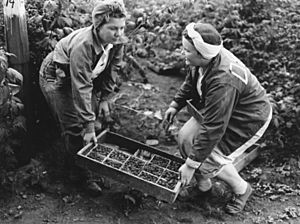
Oregon's varied landscapes are great for many types of farming. The Willamette Valley has very rich soil. This is because of the Missoula Floods long ago, which left behind lake sediment. In 2016, the Willamette Valley produced over 100 million pounds of blueberries. The Oregon Department of Agriculture helps manage and support farming in the state.
Oregon is also one of the world's main areas for growing hazelnuts. It produces 95% of the hazelnuts grown in the United States. Wine production in Oregon has a long history, but it became a big industry in the 1970s. In 2005, Oregon had 303 wineries, ranking third in the U.S. Many grapes grown in Oregon are similar to those found in French regions like Alsace and Burgundy. In 2014, 71 new wineries opened. Today, there are 676 wineries, a 12% increase from 2013.
Along the southern Oregon coast, cranberries are a major crop. They make up about 7% of U.S. production. Cranberry farms cover about 27,000 acres in Coos and Curry counties, especially around Bandon. In northeastern Oregon, near Pendleton, farmers grow both irrigated and dry land wheat. Oregon farmers and ranchers also raise cattle, sheep, and produce dairy products, eggs, and poultry.
Forests and Fishing

Oregon's huge forests have historically made it a top state for timber production and logging. However, forest fires like the Tillamook Burn, too much harvesting, and legal battles over managing federal forests have reduced timber output. Between 1989 and 2011, the amount of timber harvested from federal lands in Oregon dropped by about 90%. But logging on private land has stayed about the same.
Even with a shift towards making finished goods like paper and building materials, the timber industry has continued to decline. This decline has led to high unemployment in rural areas. Despite these changes, Oregon still leads the U.S. in producing softwood lumber. In 2011, Oregon produced 4.134 billion board feet of lumber.
Oregon also has one of the world's largest salmon-fishing industries. However, ocean fishing has reduced the amount of fish in rivers in recent years. Because Oregon has so many rivers, it is also a major producer of hydroelectric energy (electricity from water power).
Fun and Tourism
Tourism is a strong industry in Oregon. People visit to see the state's natural beauty. This includes mountains, forests, waterfalls, rivers, beaches, and lakes. Popular spots are Crater Lake National Park, Multnomah Falls, the Painted Hills, the Deschutes River, and the Oregon Caves. Mount Hood and Mount Bachelor attract visitors all year for skiing and other snow activities.

Portland has the Oregon Museum of Science and Industry, the Portland Art Museum, and the Oregon Zoo. The zoo is the oldest west of the Mississippi River. The International Rose Test Garden is another popular place in the city. Portland is also known for its amazing street food. Oregon is home to many breweries, and Portland has the most breweries of any city in the world.
The Oregon coast also attracts many tourists. The Oregon Coast Aquarium in Newport is a large aquarium that was once home to Keiko the orca whale. It is considered one of the top ten aquariums in North America. Fort Clatsop in Warrenton has a replica of Lewis and Clark's camp from 1805. The Sea Lion Caves in Florence are the largest system of sea caverns in the U.S.
In Southern Oregon, the Oregon Shakespeare Festival in Ashland is a big draw. Other attractions include the Oregon Vortex and the Wolf Creek Inn State Heritage Site. This historic inn is where Jack London wrote his 1913 novel Valley of the Moon.
Oregon has also been a popular place for filming movies because of its varied landscapes and its closeness to Hollywood. Many movies have been filmed in Oregon, including The Goonies, Free Willy, and Stand By Me. Matt Groening, who created The Simpsons, is from Portland. He has put many references to his hometown into the TV show. Several TV shows have also been filmed in Oregon, such as Portlandia and Grimm. The Oregon Film Museum is in Astoria. Also, the last remaining Blockbuster store in the world is in Bend.
Technology and Innovation
High-tech industries in an area called Silicon Forest have provided many jobs since the 1970s. Tektronix was Oregon's largest private employer until the late 1980s. Then, Intel built and expanded several facilities in eastern Washington County. This continued the growth that Tektronix started. Intel is now Oregon's largest for-profit private employer. It has four large facilities in Hillsboro.
Many new companies started from these two tech giants, leading to the "Silicon Forest." The economic downturn and "dot-com bust" of 2001 hit the region hard. Many high-tech companies reduced staff or closed down. In 2004, Open Source Development Labs hired Linus Torvalds, who created the Linux kernel. In 2010, the biotechnology company Genentech opened a $400 million facility in Hillsboro to make more products.
Oregon is also home to several large data centers. These centers use Oregon's cheap electricity and cool climate to save on cooling costs. Google has a large data center in The Dalles. Facebook built a big data center near Prineville in 2010. Amazon opened a data center near Boardman in 2011 and a fulfillment center in Troutdale in 2018.
Healthcare Services
Oregon has many healthcare providers. As of 2018, Cambia Health Solutions had the largest share of the health insurance market. Providence Health was second. In the Portland area, Kaiser Permanente is a leader. Providence and Kaiser both run hospitals and offer insurance plans. Other hospital systems in Oregon include Legacy Health (mostly in Portland), Samaritan Health Services (five hospitals across the state), and Tuality Healthcare (western Portland area). In Southern Oregon, Asante runs several hospitals, including Rogue Regional Medical Center. Some hospitals are part of larger national groups, while others, like Salem Hospital, operate independently.
Oregon Health & Science University in Portland is a medical school that also runs two hospitals and clinics.
The Oregon Health Plan is the state's Medicaid managed care plan. It is known for its new ideas in healthcare.
Taxes and Money for the State
Oregon's state budget is planned for two years at a time (biennial). In 2017, the budget was $2.6 billion. This money comes from different sources, including general funds, federal funds, and lottery funds.
Oregon is one of only five states that does not have a sales tax. Oregon voters have always said no to a sales tax. They have voted against it nine times. The last time, in 1993, 75% of voters said no.
The state also has a very low minimum tax for corporations, just $150 a year. Because there is no sales tax and low corporate taxes, Oregon relies on property and income taxes for its money. Oregon has the fifth highest personal income tax in the nation. In 2005, Oregon ranked 41st out of 50 states for taxes paid per person, with an average of $1,791.45.
Some local governments do have small sales taxes on services. For example, the city of Ashland collects a 5% sales tax on prepared food.
The City of Portland has an Arts Education and Access Income Tax. People over 18 who earn more than $1,000 a year and live in a household above the poverty level pay a flat $35 tax. This money helps fund Portland school teachers and art non-profit groups.
Oregon also allows transit districts to collect an income tax from employers and self-employed people. The state currently collects this tax for TriMet and the Lane Transit District.
Oregon is one of six states with a "kicker law." This law says that if income tax collections are more than 2% higher than what state experts predicted, the extra money must be given back to taxpayers. Since this law started in 1979, refunds have been given out in seven of the eleven two-year budget periods. In 2000, voters approved a change to the "kicker law," making it part of the Oregon Constitution.
Federal payments to county governments used to replace timber money. These payments started when logging in National Forests was limited in the 1990s. Now, these payments are at risk of stopping. This is a big concern for rural counties, which depend on this money for important services.
About 55% of state money is spent on public education. 23% goes to human services (like child protective services and senior care). 17% is for public safety, and 5% is for other services.
Big Companies in Oregon
Oregon is home to the main offices of many large companies. The world headquarters of Nike is located near Beaverton. Medford is home to Harry and David, which sells gift items. Medford also has the national headquarters of Lithia Motors. Portland is home to Graphic Arts Center Publishing, one of the largest book publishers in the West. Oregon also has Mentor Graphics Corporation, a world leader in electronic design software, located in Wilsonville. It employs about 4,500 people worldwide.
Adidas Corporation's American Headquarters is in Portland. It employs about 900 full-time workers. Nike, in Beaverton, employs about 5,000 full-time people at its 200-acre campus. Both Nike and Adidas are often ranked as top employers in the Portland area. Intel Corporation employs 22,000 people in Oregon, mostly at its Hillsboro campus. Intel has been a top employer in Oregon since 1974.
| # | Corporation | Headquarters | Market value (billions US$) |
|---|---|---|---|
| 1. | Nike | Beaverton | 91.35 |
| 2. | FLIR Systems | Wilsonville | 4.77 |
| 3. | Portland General Electric | Portland | 4.05 |
| 4. | Columbia Sportswear | Beaverton | 4.03 |
| 5. | Umpqua Holdings Corporation | Portland | 3.68 |
| 6. | Lithia Motors | Medford | 2.06 |
| 7. | Northwest Natural Gas | Portland | 1.7 |
| 8. | The Greenbrier Companies | Lake Oswego | 1.25 |
The U.S. Federal Government and Providence Health systems are also major employers in Oregon. The federal government employs about 12,000 workers, and Providence Health employs about 14,000.
In 2015, seven companies based in Oregon were listed in the Fortune 1000 (a list of the largest U.S. companies by revenue). These included Nike, Lithia Motors, and Columbia Sportswear.


